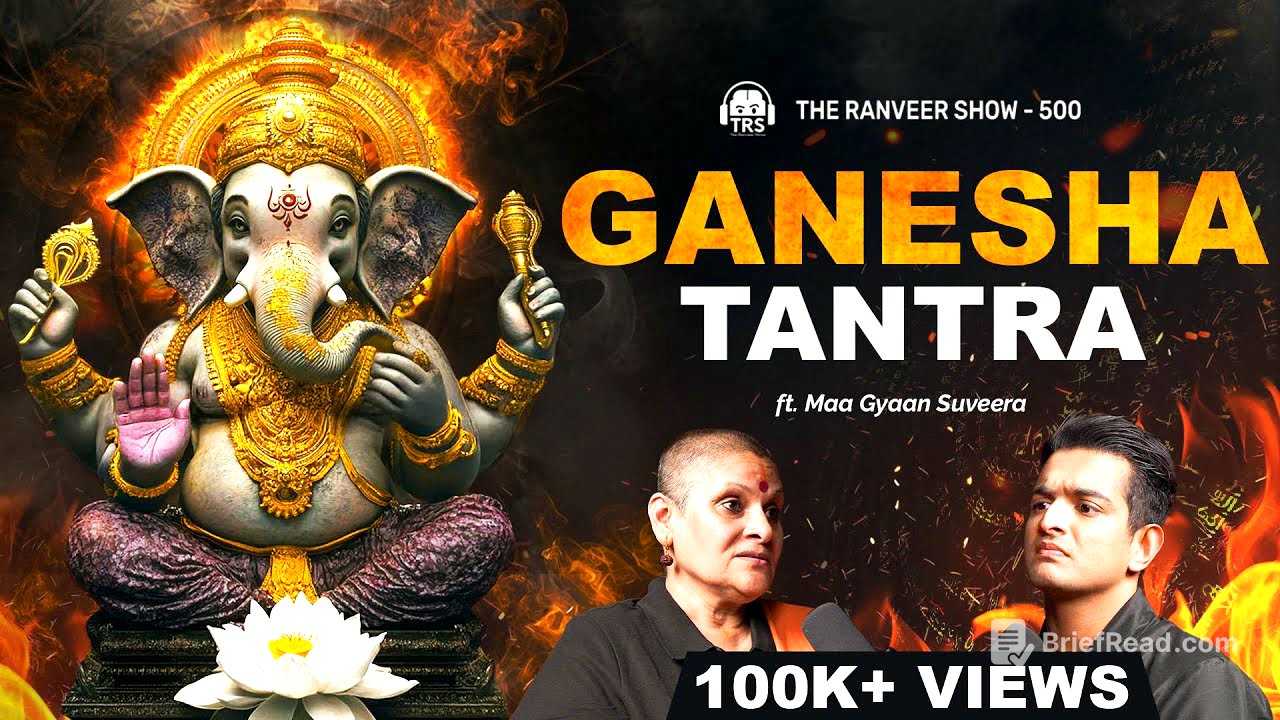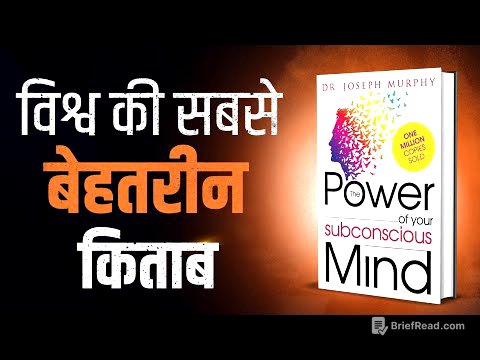TLDR;
This podcast episode features Marian Swira discussing Gpati Tantra and Sanatan Dharma. She shares insights on starting a Ganesh sadhana, the importance of dissolving the ego, and the role of deities in guiding individuals. The conversation touches on practical steps for beginners, the significance of intention, and the concept of Maruts as energy particles. Swira also addresses common misconceptions in bhakti and emphasizes the importance of inner voice and guru's guidance.
- Starting Ganesh Sadhana
- Dissolving Ego
- Role of Deities
- Importance of Intention
- Concept of Maruts
Beginning a Ganesh Sadhana [0:00]
Marian Swira suggests that when starting a Ganesh sadhana, one should first decide on the purpose, which is to dissolve the ego into the deity. Instead of experimenting with different deities, it's better to commit to one, understanding that all deities ultimately merge into Parmatma. The deity will guide the sadhana through inner voice, people you meet, and resources you find. It's important to start with basic mantras and practices, gradually building up intensity, to prepare the body for higher practices.
Establishing a Loving Relationship with the Deity [7:48]
A loving relationship with the deity is very important, and the deity will teach you through an inner voice. Begin your journey with faith, trust, and surrender, understanding that the deity is a loving system, not a punishable one. Consciously establish a loving relationship, and guidance will come. Approach people who don't instill fear, as fear is anti-spiritual. Start with simple deities and practices, building up inner potential gradually, and a guru will eventually come into your life.
Practices and Offerings in Sadhana [9:34]
Lighting a diya is a great first step, and there are no strict rules about using ghee or oil. The purpose is to invoke the flame within. God isn't concerned with the specifics of offerings but with the intention behind them. Learn to light a lamp and invoke the light within, using simple mantras or heartfelt prayers in any language. The deity recognizes the root of your intentions, so approach sadhana with love and surrender, not material gain or aggressive spiritual growth.
The Role of Upanishads and the Concept of Brahma Gyaan [17:40]
Stotras and bhajans are great for beginners. The Atharvashirsha Upanishad, connected with Ganesha, is a part of sadhana. Reciting the Upanishad alongside the moola mantra helps in taking the help of bhakti yoga with the mantra and kana yoga with the help of Upanishad. Reading the Upanishads a million times, internalizing it, purifies the senses and quiets the system. Every Upanishad declares that you are Brahma, Vishnu, and everything, guiding you to Parmatma.
Seeking Guidance and Dissolving Sectarian Differences [22:10]
After practicing the basics for 3-6 months, seek out experienced individuals for guidance. Approach mature minds and sadhaks, not just pundits. Trust your inner feelings when chanting mantras or reading Upanishads, and let go of confusion. Silence is important to listen to your heart and soul. Consciousness speaks to consciousness, and if you can't hear it in silence, someone will convey it to you.
The Importance of Pausing and Reflecting in Sadhana [26:54]
When your body or head tells you to stop during mantra recitation, pause and reflect. This is when the deity may be speaking to you. The ego is burnt in the mantra, and communication with the deity becomes important. Counts are given to train the ego and mind. When they are tired, your system is open to receive what the deity wants to give you. You may also continue without a count, leading to ajapa japa, where the mind repeats the mantra continuously.
Stages of Bhakti and the Deity's Love [31:04]
There are three stages in bhakti: imposing a system, anchoring into the deity, and the physical anchor melting into a subtle faith. In the second stage, you don't feel complete without the deity. In the third stage, the connection is constant throughout the day. The deity loves you more than you love the deity and chooses you because they have already fallen in love with you.
Symbolism of Animals and Frequencies of Deities [32:50]
Deities have connections with their vahans, herbs, and flowers, which are vibrational frequencies they correlate with. Animals are symbolic, like the black dog with Beer, representing his power. The mind is a fantastic machine, and when we understand these correlations, they become a reality. The whole nature is inside and outside of you, so relating with correspondences puts you in that vibe.
Symbolism of the Mouse and the Intellect [35:59]
The mouse represents the ego, and Ganesha rides it, symbolizing that the intellect rides the ego. The mouse is destructive, and Ganesha controls it with his intellect. Intellect is the discriminating power, and in vidantic scripture, the mind is classified into man, buddhi, chitta, and ahankar. Buddhi, or intellect, discriminates based on memory and ego. The purpose of sadhana is to minimize the ego and let your buddhi ride over it.
Understanding Chitta and the Process of Sadhana [41:41]
Chitta is your unconscious mind, containing traumas and old conditioning. It's the conscious mind working with the unconscious mind. The aim of sadhana is to make your chitta shant, bringing peace to it. Liberate your conscious mind from the unconscious and connect it with the higher mind, which is connected to the deities. Your higher mind becomes adin (submitted) to the deity, allowing the deity to speak to you.
The Concept of Maruts and Hanuman's Power [44:02]
Maruts are intrinsic to the panic system and are born to the vayu's movement in the sun. The word Marauti in Hanuman comes from Marut. Hanuman is a living deity, and people have seen him. When a bhakta is completely surrendered, Parmatma creates a dashion (vision) through the maruts in the body. Hanuman is linked to physical powers and siddhis, which come from the maruts.
Maruts as Particles of Light and Energy [49:44]
Maruts are high-velocity particles near the sun, born to the spand of Shivashakti. Prana is every kind of energy, and when we do pranayam, we bring the life force energy inside us into control. Maruts are like floating particles on prana, the soldiers of the prana. Increasing the number of maruts in your body through sadhana allows you to manifest anything.
The Journey of Bhakti and the Importance of Self-Analysis [52:30]
God lets you play in the nursery school as long as you want, then takes you up to graduation. When you come into bhakti, you understand that God uplifts you. The doer is the ego, and the ego goes battling everywhere. Time comes for everyone, and even those who are ignorant are on their journey. To judge is to fall down in your bhakti. Quietly watch everything and analyze only oneself.
Categorizing Deities and the Approach to Diet in Sanatan Dharma [54:16]
Ganesha is placed in the Gapata sra, a fourth sra. Rules are made like schools have rules, but love is paramount. There are three categories of followers in all the sraayas: satvic, rajasic, and tamasic. The non-vegetarian food is not critically looked at per se, but after a certain stage, one needs to be watchful about how the energy is moving in them. Any food in your refrigerator can be good or bad for you.
The Three Approaches to Sadhana and the Beauty of Sanatan Dharma [1:01:28]
Satwic, rajasic, and tamasic approaches to sadhana exist in all the sraas. The beauty of Sanatan Dharma is that for every level of person, there is a path. Even the crudest person has sadhana and a deity. These are all stages of evolution, and bhakti also evolves.
Common Mistakes in Bhakti and False Notions [1:03:01]
Misunderstandings and false conditionings, such as associating events with wearing black or touching certain things, are common mistakes in bhakti. Whatever you consider to be real, your whole being responds to it. The journey of spiritual sadhana is to uncondition yourself completely and give yourself into the open ground of Parmatma. We are all born to darkness and progressing towards the light, so all colors are good.









